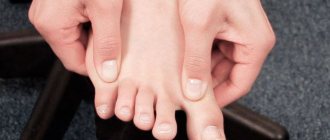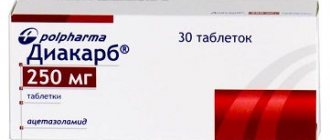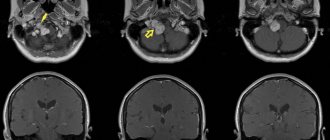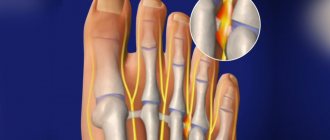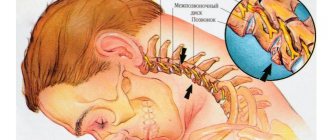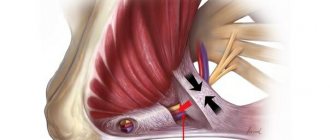This disease comes unnoticed: it is not visible, and even pain is not felt at first. "What is this?" - you ask. This is Morton's neuroma. And what kind of illness this is, how to recognize it and cure it, we will now tell you.
- What is Morton's neuroma?
- Why does Morton's neuroma appear: 6 main reasons
- How to recognize a neuroma if it is not visible?
- You have Morton's neuroma: which doctor should you see?
- Drug treatment for Morton's neuroma
- Treatment of Morton's neuroma at home: ointments, creams and gels
- Folk remedies for the treatment of Morton's neuroma
- 4 orthopedic products for the treatment of Morton's neuroma
- Gymnastics (physical therapy) for Morton's neuroma
- Massage and self-massage for Morton's neuroma
- If all else fails: surgical treatment of Morton's neuroma
- What shoes to wear if you have Morton's neuroma
- Conclusion: how to defeat Morton's neuroma?
What is Morton's neuroma?
In Morton's neuroma, the nerve sac between the third and fourth joints of the toes becomes inflamed.
As a rule, neuroma is a consequence of advanced transverse flatfoot. The fact is that a healthy foot rests on the heads of the 1st and 5th joints of the toes. With transverse flatfoot, the transverse arch of the foot loses its arch shape, and the entire load is transferred to the joints of the 3rd and 4th toes. The foot “spreads” and the nerve endings remain pinched at the tops of the joints. Inflammation begins.
Elena Malysheva talks about what Morton's neuroma is in the program “Live Healthy!”
How to recognize a neuroma if it is not visible?
At the initial stage of the disease, when the size of the neuroma is less than 5 mm, you will not even feel its presence. And only then does the main symptom appear - pain in the area of the 3rd and 4th toes.
At first, the forefoot will begin to hurt when you step on your foot. Each step will be accompanied by shooting, aching pain in the area of the 3rd and 4th toes. And only at night, during long periods of rest, the pain will subside.
If treatment for Morton's neuroma is not started in time, the disease will begin to progress. It will hurt more often and more intensely, and not only when walking, but even at night. The pain will become sharp, burning and unbearable.
Here are a few more signs of Morton's neuroma (but not required):
- Pebble feeling in shoes
- When palpating the area of the 3rd and 4th fingers, the pain increases sharply
- Loss of sensation, numbness in toes
- Mild redness and swelling in the hollow between the 3rd and 4th toes
You have Morton's neuroma: which doctor should you see?
So, we told you how to recognize Morton's neuroma. Who should you contact if you suspect this disease? Let's figure it out.
Your local internist or family doctor . The doctor will identify the presence of a neuroma and make a preliminary diagnosis, or maybe prescribe diagnostics - x-rays, ultrasound or MRI. He will also refer you for a consultation to one or more specialized specialists who will confirm or refute the diagnosis, as well as provide qualified assistance.
For example, the specialty of a podiatrist is to identify and treat foot disorders. A neurologist , taking into account the nervous nature of the disease, will find out whether the pain is associated with damage to the nerve endings. An orthopedist will make a diagnosis taking into account age-related changes in joints and ligaments. He will be able to recognize an enlarged, inflamed neuroma node. An appointment with a rheumatologist is indicated if there is a suspicion that foot pain is the result of salt deposition in the joints. with a vascular surgeon is also prescribed . Its mission is to confirm or refute the presence of blood clots in the vessels of the legs. If you have had leg injuries in the past, it is worth visiting a traumatologist who will check for fractures or dislocations. If the disease is advanced, the therapist will probably refer you to a surgeon .
Drug treatment for Morton's neuroma
The best way to get rid of neuroma is with medications. They are taken orally or injected into the painful area.
Blockade for Morton's neuroma (performed only by a doctor!)
A blockade is an injection therapy that is indicated for unbearable pain caused by a neuroma. An experienced specialist injects painkillers and corticosteroids into the affected area.
- Pain-relieving injections act instantly, but their effect lasts for a maximum of several hours.
- Corticosteroid drugs “switch off” the nerve and relieve inflammation for a long time. Their disadvantage is that they begin to act only 1-4 days after the injection. But the “fat” plus is a long-lasting effect, up to 4 weeks. In rare cases, one blockade can relieve the patient of pain forever.
Anti-inflammatory tablets for Morton's neuroma
For Morton's neuroma, your doctor will prescribe non-steroidal anti-inflammatory drugs, such as ibuprofen or naproxen. These medications do not get rid of the neuroma, but they can help reduce swelling, relieve inflammation, and relieve pain.
What is polyneuropathy of the lower extremities
The name of the disease is translated from Greek as “disease of many nerves,” and this translation fully conveys the essence of polyneuropathy of the lower extremities. In this case, almost all endings of the peripheral nervous system are affected.
There are several forms of the disease:
- Sensory polyneuropathy of the lower extremities. It manifests itself to a greater extent as a sensitivity disorder in the affected area, for example, numbness, a tingling or pins and needles sensation, a burning sensation. Treatment consists of controlling sensory symptoms with medications. Distal sensory polyneuropathy of the lower extremities brings a lot of inconvenience to the victim, since initially suspecting the disease is quite problematic, but the longer treatment is delayed, the more difficult it will be.
- Motor. The main symptom is muscle weakness to the point of complete inability to move arms or legs. This can very quickly lead to muscle atrophy.
- Sensorimotor. Combines symptoms of sensory and motor polyneuropathy. In most cases, this form is diagnosed.
- Vegetative. It differs in that in the foreground there are symptoms of damage to vegetative fibers. Direct symptoms include paleness of the skin, increased sweating, dizziness, disruption of the gastrointestinal tract, constipation, and tachycardia. Autonomic disorders signal several problems at once, so it is imperative to consult a doctor.
- Mixed. This form is diagnosed if all of the above symptoms are observed.
Expert opinion
Author: Alexey Vladimirovich Vasiliev
Neurologist, Head of the Research Center for Motor Neuron Disease/ALS, Candidate of Medical Sciences
Polyneuropathy is a complex disease characterized by atrophy of nerve fibers as a result of disturbances in the functioning of the peripheral nervous system. The pathology affects the upper and lower extremities and is accompanied by impaired sensitivity of the integumentary tissues, muscle performance, and deterioration of blood circulation.
Polyneuropathy is divided into 2 types:
- Primary is deadly, can be observed in any healthy person, progresses very quickly, and often ends in Landry’s paralysis.
- Secondary develops as a result of metabolic disorders and is a consequence of diabetes mellitus, vitamin deficiency in the body, general intoxication, infections, and injuries.
Symptoms of polyneuropathy of the lower extremities are pronounced. Initially, a person feels weakness in the legs, a feeling of numbness of the feet appears, gradually spreading to the entire limb. Some patients complain of burning and pain, tingling in the legs; in advanced cases, there is an unsteady gait and dysfunction of motor skills. Depending on the severity of the condition, symptoms such as dark circles under the eyes, dizziness, weakness, and tremors may appear. Doctors at the Yusupov Clinic will examine the patient, based on comprehensive diagnostics, identify an accurate diagnosis, and prescribe treatment in accordance with the general condition and side symptoms of the disease.
Treatment of Morton's neuroma at home: ointments, creams and gels
Ointments and creams will not get rid of Morton's neuroma, but they will help relieve the symptoms:
- Reduce pain;
- Relieve swelling;
- Reduce inflammation;
- Increase mobility of the painful area.
The main active components of ointments for the treatment of Morton's neuroma are diclofenac, indomethacin, ibuprofen and ketoprofen.
Be sure to discuss the use of external agents for Morton's neuroma with your doctor. Pharmacy medications often have contraindications.
Folk remedies for the treatment of Morton's neuroma
Folk remedies also do not cure Morton's disease, but they help brighten the lives of its owners. They relieve pain, reduce inflammation and relieve swelling.
Homemade ointments - we prepare it ourselves
Homemade ointments are made from ingredients that you can buy at a pharmacy, grocery store, or grow in your garden.
Animal fat based ointment
Ingredients:
- Pork, badger or goose fat - 100 grams (sold in pharmacies and cosmetic stores)
- Table salt - 1 tablespoon
Mix the ingredients thoroughly and transfer the mixture into an empty container, such as a cream jar. Rub the ointment onto the inflamed area daily or apply it under a bandage at night.
Ointment with bay leaves and pine needles
Ingredients:
- Bay leaf - 2 tablespoons
- Pine needles (can be bought at a pharmacy or collected in the forest) - 1 tablespoon
- Butter - 50 grams
Chop and mix bay leaves and pine needles. Add butter and mix thoroughly. Apply the ointment to the affected area daily.
Treatment of Morton's neuroma with herbs
Herbs are another gentle self-help option for Morton's disease. There are many options for using them: compresses from ground leaves, lotions from fresh plant juice, tinctures and decoctions.
- Wormwood compress. Grind the wormwood leaves into a paste and soak a piece of gauze in the juice or wrap the paste in it. Apply the compress to the toe area, secure it with a bandage and leave overnight.
- Kalanchoe compress. Squeeze the juice of fresh Kalanchoe, soak a cotton pad in it and apply to the area of the 3rd and 4th toes. If you don’t want to squeeze out the juice, “beat” a dense leaf of the plant so that it becomes wet and apply it.
- Burdock root decoction. Prepare a decoction: 2 tablespoons of raw materials per 2 liters of boiling water. Let the mixture simmer over low heat for three to five minutes. Cool the broth, soak a piece of gauze in it and apply to the painful area overnight.
- Tincture of marsh cinquefoil with vodka. Place cinquefoil stems in a glass bottle (0.7 l) and fill with vodka. Infuse the medicine for two weeks, shaking occasionally. Use the prepared tincture for compresses and rubs.
- Alcohol tincture on white acacia inflorescences. Fill the acacia flowers with alcohol and leave for two weeks. Use the prepared tincture to apply lotions to the area of the neuroma.
- Foot baths with herbal mixtures. Pour a liter of boiling water over 4-5 tablespoons of dried herbal mixture. Boil the broth for 3-5 minutes over low heat, then cool and let it brew under the lid for an hour. After this, pour the broth into a bowl of warm water. Immerse your feet in the bath for 15-20 minutes, repeat this procedure daily, preferably before bed. You can use herbal mixtures:
- Blend No. 1: chamomile + sage + yarrow
- Mixture No. 2: lavender + calamus root + kelp + pine needles
- Mixture No. 3: calendula + mint leaves + chamomile flowers
Treatment of Morton's neuroma with products from your kitchen - cheap and accessible
You can cope with the unpleasant symptoms of neuroma with the help of products that you can find in your kitchen.
Warming effect: pork fat + salt
Mix 100 grams of pork fat with a tablespoon of table salt. Apply this mixture to the area of the neuroma, and then apply a bandage and put on woolen socks to get a warming effect.
Active heating: mustard + hot pepper + vodka + salt
Another way to thoroughly warm up sore feet is to rub them with mustard. Mix dry mustard powder with table salt in a 1:1 ratio. Add two crushed hot peppers to this mixture. Pour the resulting mixture with a glass of vodka or diluted alcohol and leave for a week, shaking occasionally. Then strain the tincture and rub the liquid on your feet every day before going to bed. After rubbing, be sure to wear warm socks to make the warming effect even stronger.
Anti-inflammatory - flax seed tea
Prepare a decoction: pour 4-5 tablespoons of seeds into an enamel pan and add a liter of water. Bring the water to a boil and cook the “tea” for 15 minutes. Then remove the broth from the stove, cool and strain it. Divide the flaxseed “tea” into several doses and drink half a glass daily for two weeks. If you want to make the decoction not only healthy, but also tasty, add honey or a slice of lemon to it.
Regularly at night - a whole cabbage leaf
Cabbage leaf fights inflammatory processes. To get rid of inflammation from Morton's neuroma, wrap a cabbage leaf on your sore feet every day for several weeks.
Potato compress on the sole of the foot
Grate the potatoes and place the resulting mass on a piece of gauze. Apply a compress with potatoes to the sole of your feet at night.
Effect after 1st use: mustard compress with honey
Take equal parts of dry mustard powder, sunflower oil and honey. Bring the mustard and butter to a boil, cool and mix with honey. Then moisten the bandage and apply to the sore spot for 1 hour. Use the compress daily.
For intense pain: a compress of vinegar and rose hips
Pour 5 tbsp. l. rosehip flowers with half a liter of table vinegar and leave for 1 day. Then boil the tincture in a water bath for 20 minutes, soak a piece of gauze in it and apply to your feet for acute pain.
Treatment of Morton's neuroma with propolis
Another folk remedy for the treatment of Morton's disease is propolis. Pour 20 grams of propolis into 300 milliliters of vodka or diluted alcohol. Infuse the mixture for two weeks in a dark place. After this, apply lotions from the tincture to painful areas.
How to treat Morton's neuroma of the foot?
If a patient is diagnosed with Morton's neuroma, treatment begins with reducing the weight on the foot. This is required to slow down the destructive process and prevent pain. As a first step, experts advise purchasing more spacious shoes with heels up to 4 cm or starting to wear an orthopedic model.
Also, for Morton's neuroma, you can use orthopedic insoles , which allow you to restore the optimal position of the transverse arch of the foot. As an additional device, it is recommended to use special pad inserts, which are placed at the base of the metatarsal bones.
If a patient is diagnosed with Morton's neuroma, timely measures can achieve the following effects:
- Minimize the load on the front of the foot and restore the optimal position of the transverse arch;
- Reduce the pressure of ligaments and bones on the nerve;
- Restore biomechanical functions;
- Stop inflammation near the nerve.
Use of medications
In combination with the use of orthopedic devices, Morton's neuroma can be treated with medications:
- In case of a painful attack of increased intensity, the hormonal drug Diprospan or the potent painkiller Novocain are prescribed. The above medications must be used monthly;
- To relieve inflammatory manifestations and eliminate pain, steroid hormones from the subclass of corticosteroids are often prescribed, which are injected into the affected area;
- For pain of moderate intensity, it is recommended to use Baralgin, Nurofen and Ketoprofen;
- To eliminate muscle spasms, the muscle relaxants Mydocalm and Sirdalud are used.
To obtain a prolonged positive effect from the use of the above drugs, they must be used for at least three months.
Physiotherapy for Morton's disease
For Morton's neuroma, additional treatment involving the use of physiotherapeutic procedures is prescribed. Due to this, it is possible to increase the effectiveness of the use of drugs, as well as improve metabolic processes in the affected area.
So, for tunnel neuropathy, it is advisable to perform the following procedures:
- Effect on the body of an alternating magnetic field;
- Exposure to shock waves;
- The use of needles inserted into acupuncture points;
- Exposure of the body to direct electric current simultaneously with the introduction of special medicinal compounds through the skin;
- Massotherapy. It is carried out starting from the ankle and ending with the fingertips.
In some situations, there are restrictions on the use of physiotherapeutic methods. These include:
- Presence of wounds on the skin;
- Pustular skin lesions;
- Pathologies of the circulatory system;
- Formations of a malignant nature;
- Cardiovascular failure.
Use of shockwave therapy for Morton's neuroma
As stated earlier, treatment of Morton's neuroma in Moscow begins with the use of special orthopedic devices. These include insoles, which play a key role in Morton's neuroma, as they allow you to restore the optimal position of the transverse arch of the foot. The patient is also recommended to use non-steroidal anti-inflammatory drugs, injections with steroid hormones, and painkillers.
If conservative methods do not give the desired effect, experts recommend removing Morton's neuroma. However, not all patients with this pathology undergo surgical intervention.
A more gentle and effective way to eliminate the disease is considered to be the SWT , which gives an excellent effect for Morton's neuroma - it improves blood flow in the affected area.
The technique is based on the use of shock waves that affect the nerve trunk. This provides the necessary analgesic effect, helps eliminate the inflammatory process and helps normalize restoration processes in tissues.
The advantages of the procedure also include:
- Increased comfort for the patient;
- Safety;
- Non-invasive nature;
- Quickly achieve the desired result.
In our medical]SWT[/anchor] technique is a priority way to eliminate neuroma. The use of innovative Swiss equipment, an individual approach to the problem and the high professionalism of doctors make it possible to obtain maximum efficiency in its implementation.
Removal of Morton's neuroma
If there is no positive result from conservative methods, the doctor refers the patient to surgery.
Today, the following methods are known for surgical removal of compaction in the area of the frontal part of the foot. These include:
- Resection of the formation. In this case, a small incision is made in the intermetatarsal area and the seal is completely removed. After this, suturing is performed. At the same time, there is no need to implement measures to ensure foot immobility;
- Dissection. It is considered more gentle. In this method, the affected ligament is divided into fibers, which eliminates nerve compression;
- Using a surgical laser. This procedure is famous for its low trauma and does not limit the patient’s motor activity in the future;
- Radiofrequency catheter ablation. The method is minimally invasive. For Morton's neuroma, it is carried out in combination with ultrasound diagnostics . In this case, the seal is destroyed when exposed to electric current;
- Shift of the fourth metatarsal bone. Performed in isolated situations. Using a similar procedure, it is possible to eliminate compression of the nerve. If a patient is diagnosed with Morton's neuroma, bone displacement surgery and subsequent rehabilitation are carried out under x-ray guidance.
By contacting us about seal removal, you will receive a guarantee of a safe and accurate surgical intervention, as well as quick and easy rehabilitation after it. This is due to the presence of highly qualified surgeons in the state, who have hundreds of similar operations behind them.
Treatment of Morton's neuroma with traditional methods at home
Despite the proven effectiveness of the above methods for Morton's neuroma, many patients are interested in how to treat the pathology at home . Their effectiveness with the right approach has also been confirmed. But resorting to these methods is recommended in exceptional situations, with mild forms of the disease. Below we will talk about the most effective of them:
- A bandage on the sore spot, moistened with an infusion of wormwood;
- Burdock root infusion;
- Kalanchoe juice;
- Flax seed infusion;
- A cabbage leaf that is applied to the affected area;
- Dress with an ointment made from lard and baking soda;
- Compress with ointment obtained from laurel leaves (2 tablespoons), pine needles (1 tablespoon) and butter (50 g);
- A bandage soaked in a mixture of sunflower oil, mustard and honey.
With the right approach, the above remedies can be quite effective.
Make an appointment Online booking
- Clinic on Krasnopresnenskaya +7 (499) 252-41-35 Volkov lane, 21
- Clinic on Varshavskaya +7 (499) 610-02-09 Varshavskoe highway, 75, building 1
- Clinic in Annino +7 (495) 388-08-08 Varshavskoe highway, 154, building 1
Gymnastics (physical therapy) for Morton's neuroma
Gymnastics will not only help speed up the blood and relieve pain in the legs, but will also restore the mobility of “stiff” joints. Exercises for Morton's neuroma can be divided into three groups:
- Stretching the muscles of the feet
- To strengthen the muscles of the feet
- For balance
Stretching the foot muscles
Stretching the tissues of the foot helps relieve pressure on the neuroma and therefore reduce pain. IMPORTANT: when performing each exercise, fix your foot in one position for at least 10-15 seconds.
- “Toe towards you - sock away from you”
Sit on the floor or a hard chair. Pull your toe toward your shin as tightly as possible and then extend it forward.
- "Facing the wall"
Stand facing the wall. Raise your palms to shoulder height and press them against the wall. Move one leg back 30 centimeters. Bend the knee of your front leg so that your heels remain pressed to the floor.
- "With a towel"
Grab a small towel, then sit on the floor and stretch your legs out in front of you. Place the front of your foot in the middle of the towel, and take its ends in your hands and pull it towards you.
Strengthening the foot muscles
- "Piano"
Place your feet on the floor. “Play the piano” with your fingers: alternately lift them off the floor, use those toes of both feet at the same time.
- "Pull up the towel"
Spread a towel on the floor and try to gather it into an accordion with your toes.
- "Rotation"
Rotate your foot first clockwise and then counterclockwise. Make your movements as wide as possible.
Balance exercises
It would seem, what does balance have to do with it? And here's what it has to do with it! Maintaining balance improves the biomechanics and mobility of the foot. This will reduce the pressure on the inflamed nerves and reduce the pain.
"On one leg"
Stand on one leg and start moving the other leg while maintaining balance.
"Narrow path"
Lay a narrow ribbon on the floor or mentally draw it. Try to walk along one line and maintain balance.
"Rubber"
Take a gymnastics or any other elastic band and wrap it around your legs. Stand on one leg and lift the other forward, backward and sideways, while stretching the band.
Remember the main rule of exercise therapy for Morton's neuroma: increase the load gradually so as not to aggravate the compression of the painful nerve. If after exercise you feel worse, stop doing therapeutic exercises and consult a doctor.
Massage and self-massage for Morton's neuroma
Massage for Morton's neuroma is a way to relieve pain or get rid of it completely. At the same time, the result lasts for a long time. You can entrust the massage to a professional or massage the forefoot yourself at home.
Massage from a qualified specialist
For Morton's neuroma, a course of therapeutic massage consisting of 8-14 procedures is prescribed. Medical foot massage:
- relaxes tense muscles,
- improve blood and lymph circulation,
- reduces inflammation,
- improves joint mobility,
- reduces muscle spasms.
Additional light massage of the heads of the bones of the feet reduces pressure on the inflamed nerve. Thus, the course of the neuroma is facilitated.
Self-massage for Morton's neuroma
You can perform massage yourself at home, after consulting with your doctor first. Remember that the main thing in massage for neuroma is not to put too much pressure on the heads of the foot bones. This can put even more pressure on the painful nerve and increase pain.
Ice massage for Morton's neuroma
You can relieve pain from Morton's neuroma in a “cold” way - using an ice massage. Do the following:
- Pour water into a plastic bottle or deep glass;
- Freeze;
- Massage the painful area with a bottle or glass of ice, and roll the container with your foot.
Why is it necessary to treat myositis of the leg?
Modern medical practice has reliable means that can successfully treat leg myositis. Early contact with a doctor is of great importance. An advanced disease takes longer and is more difficult to treat.
What will happen if you don’t go to the doctor?
Unfortunately, home remedies will not lead to a complete cure. The pain will subside, but in the presence of unfavorable factors it will return - the disease will take a chronic form. And frequent relapses can cause gradual muscle atrophy - this is a very serious problem.
If all else fails: surgical treatment of Morton's neuroma
If conservative methods of treating a neuroma do not bring relief, the only way to get rid of the neuroma is surgery. Morton's neuroma can be cauterized, cut out with a scalpel, or removed with a laser.
Radiofrequency ablation - “cauterization” of Morton’s neuroma
The essence of ablation is to cauterize the inflamed tissue, that is, to remove Morton's neuroma. The operation lasts only 15-30 minutes and is performed under local anesthesia. The doctor inserts a thin needle into the affected area, through which an even thinner probe is inserted. The end of the probe is heated to 85 degrees Celsius, and the high temperature destroys the painful nerve. The very next day you can start working and gradually return to your usual activities. The effectiveness of radiofrequency ablation reaches 80%, but in some cases a repeat procedure may be required.
Surgical removal of Morton's neuroma
Removing a neuroma is a simple operation that takes place under general anesthesia and in a short time. The surgeon can perform surgery on both the dorsum of the foot and the plantar side. The choice of surgical method is entirely in the power of the doctor.
Removal of Morton's neuroma with laser
Many clinics use a laser instead of a scalpel. The laser has several advantages over a scalpel:
- Low trauma;
- After the operation there is almost no pain;
- The laser wound heals faster;
- Shorter recovery time.
Perhaps surgery is the “iron” way to get rid of neuroma. However, it also has disadvantages: high cost, stress on the body due to anesthesia, time for rehabilitation and risks, although minimal.
Recovery prognosis
The prognosis is quite favorable. If there is no result from the use of conservative methods, complications can be prevented by removing Morton's neuroma with a laser. This helps prevent further loss of foot function and complete loss of motor activity.
If the patient turns to a specialist at the initial manifestations of the disease, it will be possible to stop the inflammation through physiotherapeutic methods and medications. In the absence of timely treatment measures, this is fraught with serious complications. The affected area expands, and painful attacks become longer and more intense. In advanced stages of the disease, Morton's neuroma can only be treated through surgery, which is confirmed by reviews.
What shoes should I wear if I have Morton's neuroma?
Incorrectly selected shoes are one of the main causes of neuroma, remember? It deforms and injures the bones and joints of the feet, and they, in turn, pinch the inflamed nerve even more.
That's why the first thing you need to do is change your shoes.
Getting rid of high heels
Expanding space in shoes
Adding softness
Causes of Morton's neuroma formation
In the development of foot neuroma, both endogenous factors and genetic causes are of key importance. The etiological factors involved in the formation of carpal tunnel syndrome include: excessive load on the front of the foot associated with frequent wearing of high-heeled/flat shoes or tight shoes; the presence of hematomas in the area where the nerve is located; flat feet; traumatic lesions of the feet (fractures, bruises); overweight; long walking; various pathological processes in the vascular area; infectious diseases; the presence of benign tumors in the foot area, etc.
